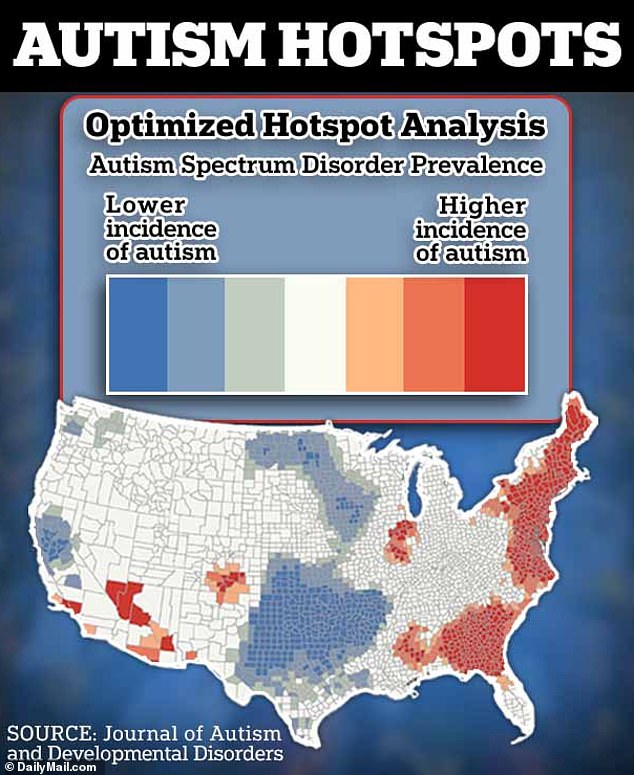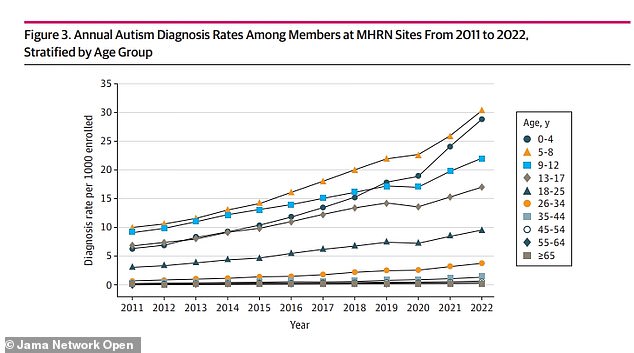Donald Trump has expressed shock at a medical trend that has puzzled doctors for decades: why are autism rates rising so quickly in the US?
In a late night Truth Social post Tuesday, the president wrote: ’20 years ago, Autism in children was 1 in 1,000. NOW IT’S 1 in 34. WOW!
‘Something’s really wrong. We need BOBBY!!!’ The post was referencing Robert F Kennedy Jr, who is on the verge of being confirmed as head the Department of Health and Human Services (HHS).
Trump’s numbers were slightly off — the CDC reports about seven children in 1,000 had autism in the early 2000s.
And the latest data suggests one in 36, rather than one in 34, had it in 2022, though it’s unclear if the president is privy to newer figures.
Still, experts have raised similar concerns about the rapidly rising rates of autism, which they say can’t be solely due to better diagnostics and awareness.
Dr Cooper Stone, a psychiatrist in Philadelphia, previously told DailyMail.com: ‘There is a strong belief that environmental factors may in part be implicated in developing this condition.
‘While no direct environmental causes have been linked to ASD, there are many associated risk factors that seem to have a relation.’

Donald Trump, pictured here, posted on Truth Social ‘something’s really wrong’ about rising autism rates in the US
Trump’s post also drew criticism due to the fact RFK Jr has previously endorsed debunked theories that vaccines cause autism.
But a growing body of recent research suggests other external factors cannot be dismissed as conspiracies.
Some studies have shown growing pollution and chemical contamination in food and water may allow toxins to infiltrate the bloodstream of pregnant mothers and travel to the brain of the developing fetus, causing inflammation that impairs nerve signals that lead to autism.
Some experts have also speculated a surge in pesticide use may also be responsible for lower IQs and delays in children.
Additionally, more babies are surviving being born prematurely than in decades past, making them more vulnerable to developmental delays and autism.
This could be related to the fact women are having children older than ever, or other changes to do with parents, such as the rising prevalence of obesity.
However, the increased prevalence of autism may not be a uniquely American phenomenon.
In the UK, a record 200,000 Brits in 2024 were reportedly waiting to be screened for autism, a nine-fold increase from 2019, data from the country’s National Health Service shows.
According to the latest CDC data, one in 36 children in the US have autism. This is just under 2million.
Generally, most with the disorder are diagnosed by age five, though some can be tested as young as age two.
Research published last year in JAMA Network Open found between 2011 and 2022, autism diagnoses in children between ages five and eight rose 175 percent, from two per 1,000 people to six per 1,000.
However, the biggest increase was among young adults ages 26 to 34, with a 450 percent jump, which suggests they were delayed in getting a diagnosis.
This suggests that doctors have, indeed, got better at detecting the condition rather than there being more cases.
Another recent change that happened was a tweak to the American Psychiatric Association’s diagnostic definitions a decade ago.
The updated Diagnostic and Statistical Manual of Mental Disorders (DSM-5), is used to diagnose mental conditions like anxiety, depression, and bipolar disorder.
But in 2013 the changes collapsed autism, Asperger syndrome and pervasive developmental disorder into one category, autism spectrum disorder.
This may have led to more children being considered autistic.
Dr Courtney Scott, Medical Director of Momentous Recovery Group, previously told DailyMail.com: ‘The introduction of new diagnostic criteria by the DSM-5 has resulted in the considerably wider range of presentations and behaviors that clinicians associate with autism spectrum disorder (ASD).
‘This strategy is beneficial because it also includes milder or less typical symptoms of ASD, so that more people with this disorder who were likely to be missed previously are able to be provided with comprehensive support resources.
‘Such an increase in the number of diagnoses could also be explained, in some degree, by this expanded viewpoint.’

But a series of recent studies have also suggested environmental factors like pollution could be at play.
A 2023 review found people with a genetic predisposition to autism, such as a parent having the condition, who were exposed to pollution as children were more likely to develop autism than those not exposed to it.
Older research from Harvard also found exposure to air pollution like particulate matter in early childhood may raise the risk of autism by as much as 64 percent.
While in the womb, exposure may raise risk of ASD by 31 percent.
The experts suggested particulate matter breathed in during early childhood or while in the womb may travel through the bloodstream and bypass protective layers in the brain, causing inflammation that hinders nerve development.
An Australian study published earlier this year also found boys exposed to endocrine-disrupting chemical Bisphenol A (BPA) in the womb were six times more likely to be diagnosed with autism before age 11 than those without exposure.
That team suggested BPA – which lines plastic and metal food packaging, an ever growing pollutant in the modern world – was associated with neurological and behavioral changes associated with autism.
The US has also seen a surge in the use of synthetic pesticides, which some say could be a contributor, as well.
Use of these chemicals increased 50-fold since 1950.
In 1952, for example, just one in 10 corn fields used pesticides to help kill pests. But by 1982, 95 percent of corn fields used them.
Some research indicates up to 80 percent of Americans have detectable levels of pesticides in their blood.

The above chart shows the increases in autism diagnoses from 2011 to 2022 by age group, according to research published last year in JAMA Network Open

The above chart shows the gap in autism diagnoses between males and females, suggesting that diagnoses in females are catching up to those in males
Last year, the Environmental Protection Agency (EPA) announced an emergency suspension of the pesticide dimethyl tetrachloroterephthalate (DCPA or Dacthal) due to evidence suggesting babies exposed to it in the womb could be born underweight and with a decreased IQ and development.
Additionally, a 2021 review found ‘the odds of an autism diagnosis were 3.3 times higher in individuals born preterm than in the general population,’ as premature babies are vulnerable to birth complications and inflammation associated with autism.
This means the increase in autism could be due to more preterm babies surviving birth, as the survival rate has increased from 76 percent between 2008 and 2012 to 78 percent between 2013 and 2018, according to research from the National Institutes of Health (NIH).
About one in 10 babies in the US are born preterm, according to the CDC, meaning they are born before 37 weeks gestation.
While none of the recent research has found a definitive cause for the spike in autism, Dr Scott said that it could help spot the condition earlier and prevent it.
He said: ‘Although no causes have so far been achieved, [study] results are helping unravel the enigma of ASD and in the long-run assist in the formulation of better ways of preventing and treating the condition.’














